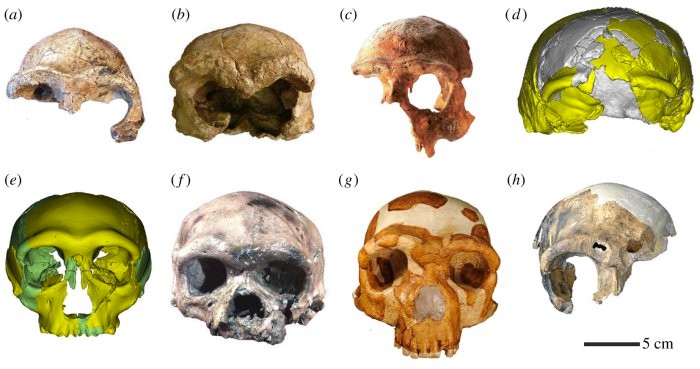Abundant Hominin Fossils Dating Back 300,000 Years Excavated In Hualongdong (HLD), East China
Excavations in Hualongdong (HLD), East China, have revealed abundant hominin fossils dating back 300,000 years. The fossils from a late Middle Pleistocene were excavated by an international team of researchers in Hualongdong (HLD), East China.

Anterior cranial profiles of Middle Pleistocene humans from China. C
They are nearly complete and fit well with a partial cranium. Thus, they together compose the skull labeled as HLD 6.
The results of the study show that the HLD 6 mandible has mosaic morphological features of early modern humans, “characterized by a robust corpus and relatively gracile symphysis and ramus. The moderately developed mental trigone and a clear anterior mandibular incurvation of the HLD 6 mandible are reminiscent of Late Pleistocene hominin and recent modern human morphology.
However, the weak expression of all these features indicates that this mandible does not possess a true chin. Moreover, a suite of archaic features that resemble those of Middle Pleistocene hominins includes pronounced alveolar planum, superior transverse torus, thick corpus, a pronounced endocondyloid crest, and a well-developed medial pterygoid tubercle,” write researchers in their paper.
The team considers the combination of both archaic and modern human features identified in the HLD 6 mandible – unexpected, “given its late Middle Pleistocene age and differs from approximately contemporaneous Homo members such as Xujiayao, Penghu, and Xiahe.”
This mosaic pattern has never been recorded in late Middle Pleistocene hominin fossil assemblages in East Asia, according to the study.
The HLD 6 fossils additionally strengthen support for the high morphological diversity during late Middle Pleistocene hominin evolution.
“With these findings, it is possible that modern human morphologies are present as early as 300 ka and earlier than the emergence of modern humans in East Asia.”
In recent years, there has been significant advance in hominin fossil discoveries and related studies in China. Interestingly, these achievements have made the late Middle Pleistocene hominin evolution scenario in China – much more complicated.
The paper states that “a recent synthetic analysis of the morphologies of the late Middle Pleistocene hominin fossils of China divided the morphological diversities of these hominin fossils into several types
These types suggest that “not all of them potentially contribute to the origin of modern humans. It is likely that during this period several hominin lineages or taxa coexisted, but only some of them may be considered putative ancestors to H. sapiens.”
Taking into account these findings, and the lack of consensus regarding the role of East Asia in the origin and evolution of modern humans, it is pertinent to investigate whether among the late Middle Pleistocene hominins in China, the hominins represented by the HLD fossils are more closely related to the origin of the H. sapiens clade in East Asia.
The international team included researchers from IVPP (Institute of Vertebrate Paleontology and Paleoanthropology, Chinese Academy of Sciences), Xi’an Jiaotong University, and the Spanish National Research Center for Human Evolution.
Related Post
A shocking documentary proves that mermaids do exist
SHOCKING Revelation: Thuya, Mother of Queen Tiye, Was the Grandmother of Akhenaten and Tutankhamun—What Ancient Egyptian Secrets Did She Leave Behind?
Breaking News: Astonishing Discoveries at Karahan Tepe Confirm an Extraterrestrial Civilization is Hiding on Earth, and NO ONE Knows!
Breaking News: Researchers FINALLY Discover U.S. Navy Flight 19 After 75 Years Lost in the Bermuda Triangle!
NASA’s Secret Investigation: Uncovering the Astonishing Mystery of the UFO Crash on the Mountain!
Explosive UFO Docs LEAKED: Startling Proof That Aliens Ruled Ancient Egypt!